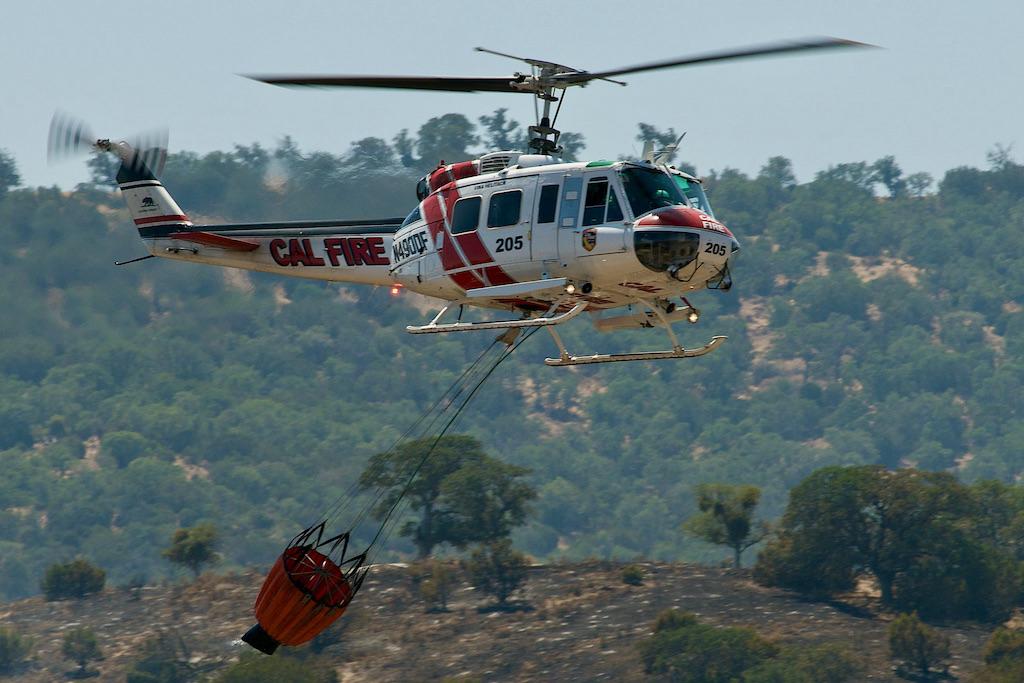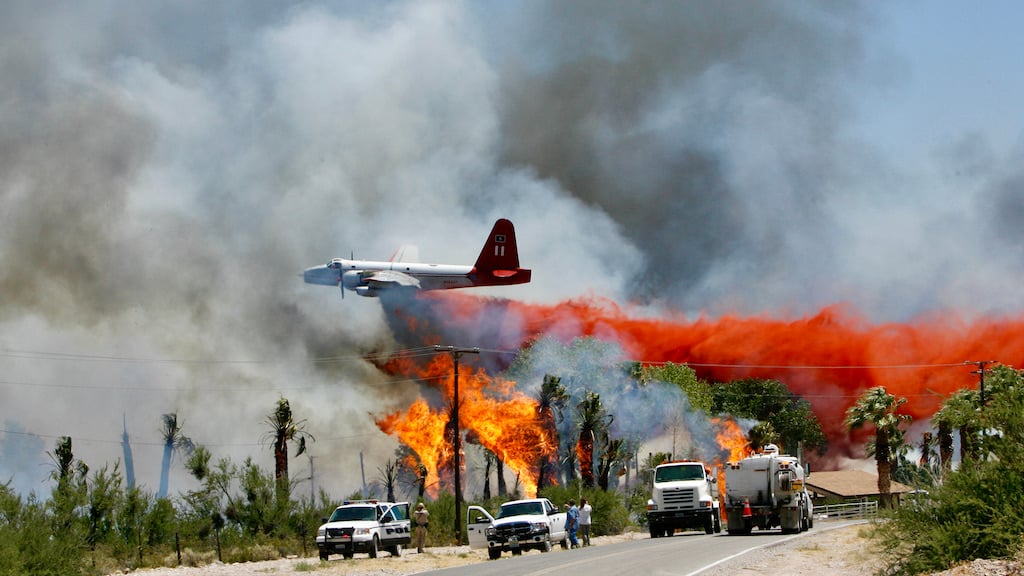
A Cal Fire Bell UH-1H with Bambi Bucket.
In a typical medium helicopter utilizing a single pilot, the pilot must be able to see the load to conduct vertical reference longline external load operations. To accomplish this, the pilot must lean out far enough to observe the load during the take-off, climb-out, approach and landing phases of flight. This exerts considerable physical stress on the neck, spinal column and ribs, especially when compared to the normal flight posture. Generally, in a hectic fire environment the pilot rarely is able to sit straight in the seat to relieve the physical stress.
If the helicopter isn’t equipped with a special windshield modified for external load work, the helmet can be exposed to the rotorwash. Drafts get into the back of the helmet and the pilot’s head gets buffeted.
On top of these physical challenges, a helicopter engaged in aerial firefighting is exposed to a synergistic mix of time pressures, adverse cabin environment, high workload, constant multi-tasking and ever-present distractions.
The adverse cabin environment includes vibrations, noise and temperatures that detract from human performance. It is well established by aeromedical research that vibrations decrease heat stress tolerance because of vaso-constriction. There are significant decrements in cognitive and psychomotor abilities within 2 hours of exposure to ambient conditions equivalent to 30 deg C. Vigilance is more vulnerable to thermal stress and is affected well before the 30 deg limit.
Military and aeromedical research has found a significant relationship between temperature and pilot error. The rate of human error increases by a factor of 1.6 with temperatures from 30-34 deg C (86-93F). The rate of human error skyrockets to a factor of 6.2 when temperatures soar above 35+ deg C (95F).
The noise levels in a single rotor helicopter have been measured between 80 to 102 dB. Noise is produced by a plethora of sources within the helicopter, ranging from powerplants, transmission systems, propellers, rotors, hydraulic and electrical actuators, cockpit advisory and alerting systems, communications equipment to the rotorwash. The internal noise spectra of today’s helicopters further includes the complex interaction of acoustic noise transmission, speech and microphone noise pick-up, which produces the total acoustic environment at the aircrew’s ears.
The flight deck of a noisy, vibrating helicopter creates considerable increases in subjective fatigue after 6 hours of short repetitive flights. There are an abundant number of special studies which found that these conditions cause increasingly frequent lapses in performance. This combination produces arguably the most overlooked flight environment contributing to fatigue and loss of SA.
Multitasking While Flying

Thus far we have briefly described the physical stress on the pilot while doing bucket work and the additional stress created by the helicopter flight deck’s environment. Now let’s consider the workload environment created when trying to simultaneously multi-task.
Coordinating one’s helicopter work with ground teams as well as with other aircraft over a fire incident is absolutely necessary for the safety of all as well as optimizing the effectiveness of each drop. Working six different radio frequencies is not uncommon.
Why so many frequencies? An aerial firefighting pilot must communicate with important team members, which can include the incident commander or a squad leader on the ground who will direct the helicopter where to drop the water as well as coordinate for the safety of the ground fire fighters immediately adjacent to the proposed drop. An errant drop on a squad of fire fighters on the fire line has the potential to produce serious injuries.
The helicopter pilot may have important information to communicate to/from the coordination center. If the fire incident occurs in airspace requiring an ATC clearance, the pilot must coordinate with the proper ATC unit. If other aircraft are working the fire to include other air tankers, smokejumper ships, etc., it is necessary to coordinate their motions with each other.
Over a busier fire a dedicated Air Tactical Group Supervisor will be overhead directing the aerial work. The auditory workload can build up to the point where the pilot can’t process any further information and begins “tuning out.”
It is also necessary for the pilot to actively monitor the aircraft’s systems and status. This includes monitoring the fuel status and staying within engine limits. The red temperature range on the engine gauge may mark the limit at which the engine can be operated. Often a helicopter’s engine has a time limitation for operating in this temperature range. A pilot has to note when the red limit was reached, track how long the temperature stayed at that limit, and remember how long the engine can be operated in the red.
Let’s not forget that the pilot has to keep track of the weather trends and especially the erratic (invisible) winds. It is completely understandable that a pilot is so fixated on these other tasks that it is easy to lose track or not accurately predict shifts in the winds. This exposes the helicopter to winds from adverse azimuths that can induce loss of tail rotor effectiveness and expose the helicopter to vortex ring state.
With all these challenges, it is a wonder that a pilot can accurately perceive information and recognize relevant elements in the surrounding environment. Furthermore, this example illustrates the difficulty of assembling all the disjointed information to form an accurate mental picture. This second level of SA goes beyond simply being aware of the elements that are present. It requires putting all the pieces of the puzzle together and having an understanding of their significance.
The ability to project ahead in time is vital to accurate situational awareness, we explain in Part 3 of this article.
Factors That Affect Pilots’ Situational Awareness, Part 1:
https://aviationweek.com/business-aviation/safety-ops-regulation/factor…





